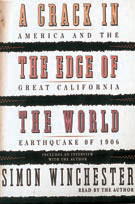
A Crack in the Edge of the World
America and the Great California Earthquake of 1906
کتاب های مرتبط
- اطلاعات
- نقد و بررسی
- دیدگاه کاربران
نقد و بررسی

Early on April 18, 1906, the San Andreas fault ruptured in an earthquake measuring 8.25 on the Richter scale. San Francisco was destroyed--first by shakes and then by fire. Simon Winchester lays out extensive history, geological background, and some pointless personal road trips before embarking on an account of the actual 'quake. He sounds like your favorite professor--mostly interesting but occasionally a little dull. The strength of his book is its oral history, which mostly translates well to audio. However, Winchester's reading is a bit uneven; his American accents are sometimes wobbly, and his pace is almost breathless. (Do Californians really speak this quickly?) Yet when he drops the accent, he is wonderful. A.B. 2006 Audie Award Finalist (c) AudioFile 2006, Portland, Maine

Starred review from July 18, 2005
In this brawny page-turner, bestselling writer Winchester (Krakatoa
, The Professor and the Madman
) has crafted a magnificent testament to the power of planet Earth and the efforts of humankind to understand her. A master storyteller and Oxford trained geologist, Winchester effortlessly weaves together countless threads of interest, making a powerfully compelling narrative out of what he calls "the most lyrical and romantic of the sciences."
Using the theory of plate tectonics introduced in 1968 by an obscure geologist, J. Tuzo Wilson, Winchester describes a planet in flux. Across the surface of the earth, huge land masses known as plates push and pull at each other. At 5:12 a.m. in 1906, the North American and Pacific plates did precisely that. Along a 300-mile fault east of the Gold Rush city of San Francisco, the earth, in Winchester's word, "shrugged." While the initial shock devastated large parts of the city, it was the firestorm that raged in the days following that nearly wiped San Francisco off the map. The repercussions of the disaster radiated out from the epicenter for years to come. Locally, Winchester finds in the records at City Hall that the destruction led to a huge rise in Chinese immigration. Winchester also cites the tragedy in the rise of the nascent Pentecostal movement, whose ranks swelled in the months and years after in the belief that the catastrophe had been a sign from God.
With fabulous style, wit and grace, Winchester casts doubt on the very notion of solid ground and invites the reader to ponder the planet they live on, from both inside and out. B&w illus. and maps.

December 8, 2005
This book benefits from being read by Winchester, who wends his way through multifaceted sentences and make us comfortable with them. Winchester writes the way he speaks, so one has the feeling of sitting in an audience at a good geology lecture that is particularly pertinent at this moment of history. Then comes a vivid verbal slide show of San Francisco before, during and after the 1906 earthquake, interspersed with fascinating speculation about the social ramifications of particularly destructive natural phenomena. The book is sometimes repetitive (offering 10 examples where three would suffice), but Winchester remains a good storyteller. The interview at the end is a nice idea, but the questions mainly reiterate important aspects of the book including his dire earthquake predictions for San Francisco and many other areas of the globe. Simultaneous release with the HarperCollins hardcover (Reviews, July 18).
Copyright 2005 Library Journal, LLC Used with permission.

October 3, 2005
This book benefits from being read by Winchester, who wends his way through multifaceted sentences and make us comfortable with them. Winchester writes the way he speaks, so one has the feeling of sitting in an audience at a good geology lecture that is particularly pertinent at this moment of history. Then comes a vivid verbal slide show of San Francisco before, during and after the 1906 earthquake, interspersed with fascinating speculation about the social ramifications of particularly destructive natural phenomena. The book is sometimes repetitive (offering 10 examples where three would suffice), but Winchester remains a good storyteller. The interview at the end is a nice idea, but the questions mainly reiterate important aspects of the book including his dire earthquake predictions for San Francisco and many other areas of the globe. Simultaneous release with the HarperCollins hardcover (Reviews, July 18).

























دیدگاه کاربران